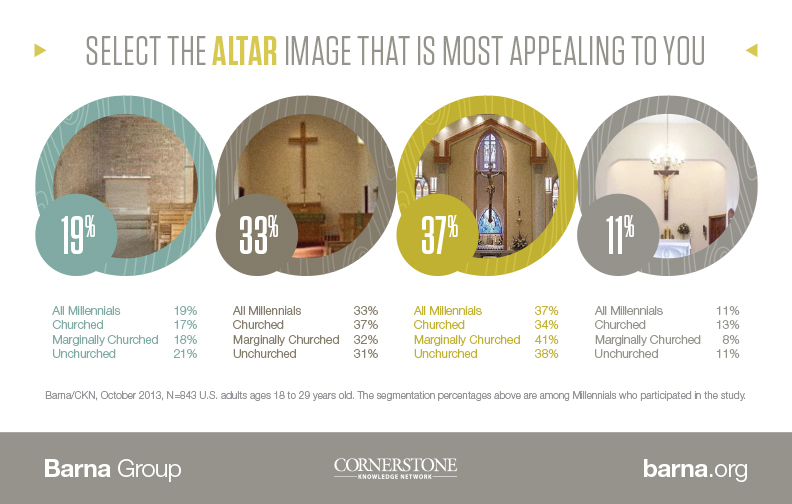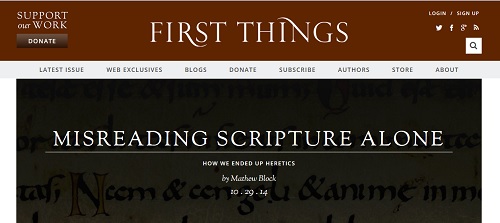Entries tagged with “Evangelicals”.
Did you find what you wanted?
Fri 14 Nov 2014

A little over a week ago we were talking about how more and more young Evangelicals prefer to participate in liturgical forms of worship. Now Barna has come out with a new study that tells us what kinds of buildings Millennials prefer to worship in. And there seems to be a definite lean towards more reverent concepts of sacred space than some might expect.
“Many churches today are explicitly constructed not to look and feel too much like a religious place,” Barna notes, “a stark contrast to the ancient cathedrals and churches of old—the very design of which was intended to help people experience the divine. How does this design shift impact worshipers?”
Let’s summarize some of their findings briefly. Most people rejected large auditorium style sanctuaries in favour of smaller sanctuaries. The vast majority prefer altars with large Christian symbols (like a cross or crucifix) as opposed to plain altar pieces. Most prefer stained-glass windows (of varying elaborate natures) to plain-glass.
In the end, the majority described their “ideal” church with these words:
Community (as opposed to Privacy)
Classic (as opposed to Trendy)
Casual (as opposed to Dignified)
Sanctuary (as opposed to Auditorium)
Quiet (as opposed to Loud)
Modern (as opposed to Traditional)
While ‘Sanctuary,’ ‘classic’ and ‘quiet’ are more often associated with traditional church buildings, less than half of survey respondents preferred the word ‘traditional’ over ‘modern,’” Barna explains, noting a bit of a “cognitive dissonance” here among young adults interviewed in the survey. “Many of them aspire to a more traditional church experience, in a beautiful building steeped in history and religious symbolism, but they are more at ease in a modern space that feels more familiar than mysterious.”
Barna’s Clint Jenkins notes that “it’s tempting to oversimplify the relationship between Millennials and sacred space,” as if they were looking only for that which is new and chic. But in reality, “most Millennials don’t look for a church facility that caters to the whims of pop culture. They want a community that calls them to deeper meaning.”
Deeper meaning. That’s what we talked about in our previous post on Evangelicals gone liturgical. “Grandeur hooked me,” Kelsey May explains, “but it wasn’t what made me stay…. The aesthetic of traditional churches appeals to me, but the substance behind it anchors me.”
Let’s make sure we offer that substance in every aspect of our church-life. Be it in liturgy or church architecture, the point is not to provide aesthetic experiences that are beautiful merely for their own sake: they are to draw us into a deeper and richer relationship with the Christ who calls us together.
See Barna’s summary of their sacred space study here.
———————
HT to Gene Veith for bringing this study to my attention.
Tags: architecture, auditorium, Barna group, church architecture, contemporary, Evangelicals, liturgy, millennials, sacred space, stained glass, traditional, Worship
Mon 3 Nov 2014

In my most recent post here on the blog, I pointed readers to a Christianity Today article that suggested “most American evangelicals hold views condemned as heretical by some of the most important councils of the early church.” In responding to this news, I noted how Christians need to take more seriously the history of the Church’s teachings.
What I mentioned just briefly here I elaborate on at length in a post for First Things. I suggest that one of the contributing causes to the re-emergence of heretical notions in contemporary Evangelicalism is a failure to proper understand the Reformation teaching of Sola Scriptura (Scripture alone). Rather than understanding it to mean that the Bible is alone authoritative, we somehow seem to have convinced ourselves that it means a solo-reading of Scripture is authoritative. As I explain at First Things, “We are right to trust in Scripture alone; but it is foolhardy to read Scripture by ourselves.”
To that end, I urge my readers to hold up their individual readings of Scripture to the scrutiny of the reading of the wider Church. It’s not because the Church has authority over the Scriptures (it doesn’t) but rather because the Church defended those things which are taught by Scripture.
We don’t follow the theological pronouncements of the Church merely because such and such a person says we should. Bishops and councils, after all, can err (remember the Robber’s Council?). But certain pronouncements—like the theological statements of the Ecumenical Councils—have long been recognized by the Church at large as true and faithful understandings of Scripture. They have codified important Scriptural truths—on the Nature of Christ, for example, and on the Personhood of the Holy Spirit—and so we refer to them as authoritative. That’s how the Nicene Creed came to be. These pronouncements do not invent new dogma not found in the Scriptures; instead, they clearly and carefully reproduce the teachings of Scripture. Consequently, they rightly norm our interpretation of the Scriptures. It’s Tradition in service to Scripture, not Tradition on the same level as Scripture.
This is, I suggest, a more accurate understanding of the Reformation understanding of the role of Tradition in the Church. I wrap up the article with some words from Melanchthon:
Philipp Melanchthon explains the Lutheran position well: “Let the highest authority be that of the Word which was divinely taught,” he explains. “Thereafter that church which agrees with that Word is to be considered authoritative.” And again: “Let us hear the church when it teaches and admonishes,” he writes, “but one must not believe because of the authority of the church. For the church does not lay down articles of faith; it only teaches and admonishes. We must believe on account of the Word of God when, admonished by the church, we understand that this meaning is truly and without sophistry taught in the Word of God.”
Read the whole thing here: “Misreading Scripture Alone: How We Ended Up Heretics.”
———————
As a side-note, Christianity Today’s managing editor Ted Olsen and I have a discussion in the comments section of my First Things article about what the recent survey does (or doesn’t) say about Roman Catholics’ and Mainline Protestants’ own heretical leanings. My argument in summary? The numbers don’t tell us anything conclusive about these other groups. Watch me crunch the numbers there.
Thu 16 Jan 2014
 The American Conservative has an interesting article entitled “Why Millenials Long for Liturgy.” You can probably guess what it’s about. A very brief selection:
The American Conservative has an interesting article entitled “Why Millenials Long for Liturgy.” You can probably guess what it’s about. A very brief selection:
America’s youth are leaving churches in droves. One in four young adults choose “unaffiliated” when asked about their religion, according to a 2012 Public Religion Research Institute poll, and 55 percent of those unaffiliated youth once had a religious identification when they were younger. Yet amidst this exodus, some church leaders have identified another movement as cause for hope: rather than abandoning Christianity, some young people are joining more traditional, liturgical denominations—notably the Roman Catholic, Anglican, and Orthodox branches of the faith. This trend is deeper than denominational waffling: it’s a search for meaning that goes to the heart of our postmodern age.
My question for readers is this: why don’t more of these young Christians looking for liturgy end up in Lutheran churches? As the article notes, most seem to go Roman Catholic, Orthodox, or Anglican.
Now it’s understandable why so many might end up Catholic. Assuming these Evangelicals are looking for a church that takes seriously the history of the Church, then Roman Catholicism is a fairly natural fit: with 67 million Catholics in the USA (about 23.9% of all Americans), they are certainly the most visible church. But why are Anglican and Orthodox churches such a drawing point where Lutherans aren’t? Anglicans and Orthodox Christians make up only 1.5% and 0.4% of all Americans respectively (2.32 million Anglican, and less than 1 million Orthodox). Lutherans, by contrast, more than double Anglicans and Orthodox put together (5.1% of all Americans, or 7.86 million people). Heck, there’s as many confessional Lutherans in The Lutheran Church—Missouri Synod alone as there are all Anglicans in the United States. So why don’t more Evangelicals-going-liturgical become Lutheran? Could it be that, despite having smaller numbers, Anglicans and the Orthodox have nevertheless presented more coherent denominational identities to the wider public? Have Lutherans been so insular that wider Christendom in North America isn’t clear who we are and what we believe?
If you’re a young Christian who went liturgical, why did you end up where you did? Had you even heard of Lutheranism? Did you (or do you even now) know what Lutherans think?
UPDATE (December 22): This post has roused interest elsewhere on the web. Gene Veith picked it up over at his blog Cranach, where more than 300 comments have accumulated in just over a day. And Anthony Sacramone provides his own go at an answer over at Strange Herring. To sum up his answer: “Lutherans are boring.” You’ll just to check out his (very good) post to see what he means by that.
——————–





